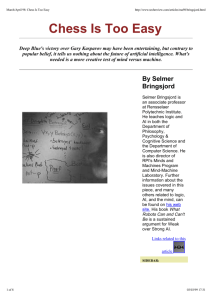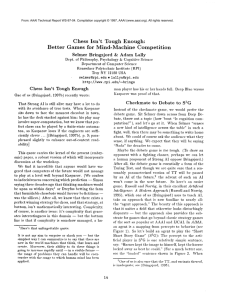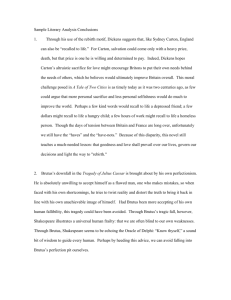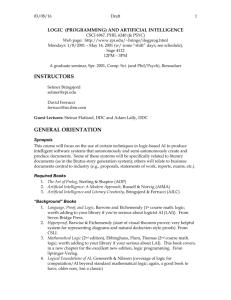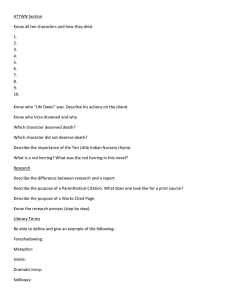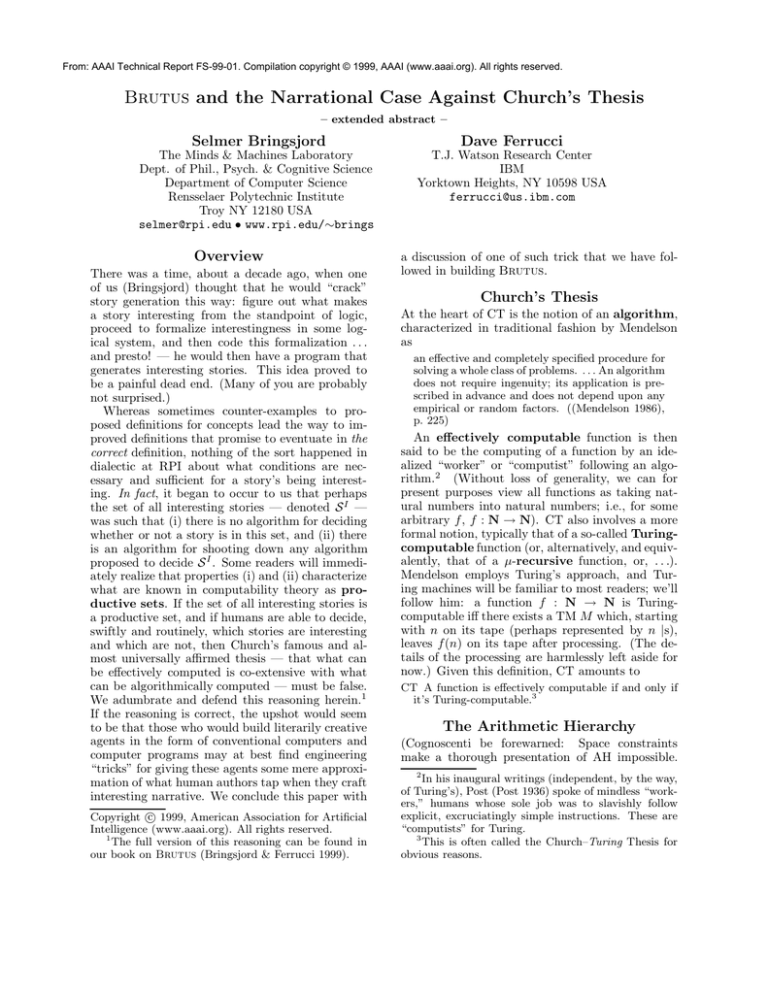
From: AAAI Technical Report FS-99-01. Compilation copyright © 1999, AAAI (www.aaai.org). All rights reserved.
Brutus and the Narrational Case Against Church’s Thesis
– extended abstract –
Selmer Bringsjord
Dave Ferrucci
The Minds & Machines Laboratory
Dept. of Phil., Psych. & Cognitive Science
Department of Computer Science
Rensselaer Polytechnic Institute
Troy NY 12180 USA
selmer@rpi.edu • www.rpi.edu/∼brings
T.J. Watson Research Center
IBM
Yorktown Heights, NY 10598 USA
ferrucci@us.ibm.com
Overview
There was a time, about a decade ago, when one
of us (Bringsjord) thought that he would “crack”
story generation this way: figure out what makes
a story interesting from the standpoint of logic,
proceed to formalize interestingness in some logical system, and then code this formalization . . .
and presto! — he would then have a program that
generates interesting stories. This idea proved to
be a painful dead end. (Many of you are probably
not surprised.)
Whereas sometimes counter-examples to proposed definitions for concepts lead the way to improved definitions that promise to eventuate in the
correct definition, nothing of the sort happened in
dialectic at RPI about what conditions are necessary and sufficient for a story’s being interesting. In fact, it began to occur to us that perhaps
the set of all interesting stories — denoted S I —
was such that (i) there is no algorithm for deciding
whether or not a story is in this set, and (ii) there
is an algorithm for shooting down any algorithm
proposed to decide S I . Some readers will immediately realize that properties (i) and (ii) characterize
what are known in computability theory as productive sets. If the set of all interesting stories is
a productive set, and if humans are able to decide,
swiftly and routinely, which stories are interesting
and which are not, then Church’s famous and almost universally affirmed thesis — that what can
be effectively computed is co-extensive with what
can be algorithmically computed — must be false.
We adumbrate and defend this reasoning herein.1
If the reasoning is correct, the upshot would seem
to be that those who would build literarily creative
agents in the form of conventional computers and
computer programs may at best find engineering
“tricks” for giving these agents some mere approximation of what human authors tap when they craft
interesting narrative. We conclude this paper with
c 1999, American Association for Artificial
Copyright Intelligence (www.aaai.org). All rights reserved.
1
The full version of this reasoning can be found in
our book on Brutus (Bringsjord & Ferrucci 1999).
a discussion of one of such trick that we have followed in building Brutus.
Church’s Thesis
At the heart of CT is the notion of an algorithm,
characterized in traditional fashion by Mendelson
as
an effective and completely specified procedure for
solving a whole class of problems. . . . An algorithm
does not require ingenuity; its application is prescribed in advance and does not depend upon any
empirical or random factors. ((Mendelson 1986),
p. 225)
An effectively computable function is then
said to be the computing of a function by an idealized “worker” or “computist” following an algorithm.2 (Without loss of generality, we can for
present purposes view all functions as taking natural numbers into natural numbers; i.e., for some
arbitrary f, f : N → N). CT also involves a more
formal notion, typically that of a so-called Turingcomputable function (or, alternatively, and equivalently, that of a µ-recursive function, or, . . .).
Mendelson employs Turing’s approach, and Turing machines will be familiar to most readers; we’ll
follow him: a function f : N → N is Turingcomputable iff there exists a TM M which, starting
with n on its tape (perhaps represented by n |s),
leaves f(n) on its tape after processing. (The details of the processing are harmlessly left aside for
now.) Given this definition, CT amounts to
CT A function is effectively computable if and only if
it’s Turing-computable.3
The Arithmetic Hierarchy
(Cognoscenti be forewarned: Space constraints
make a thorough presentation of AH impossible.
2
In his inaugural writings (independent, by the way,
of Turing’s), Post (Post 1936) spoke of mindless “workers,” humans whose sole job was to slavishly follow
explicit, excruciatingly simple instructions. These are
“computists” for Turing.
3
This is often called the Church–Turing Thesis for
obvious reasons.
What follows is in no way a detailed, accomplished
introduction to AH.4 )
Suppose we have some totally computable
predicate
S(P, u, n)
iff TM M , running program P on input u, halts in
exactly n steps (= MP : u →n halt). (Throughout AH our machines, architecturally speaking,
are always simply TMs.) Predicate S is totally
computable in the sense that, given some triple
(P, u, n), there is some program P ? which, running
on some TM M ?, can infallibly give us a verdict, Y
(“yes”) or N (“no”), for whether or not S is true of
this triple. (P ? could simply instruct M ? to simulate M for n steps and see what happens.) This
implies that S ∈ Σ0 , i.e., that S is a member of
the starting point in AH, a point composed of totally computable predicates. But now consider the
predicate H, defined by
H(P, i) iff ∃nS(P, i, n).
Since the ability to determine, for a pair (P, i),
whether or not H is true of it, is equivalent to solving the full halting problem, we know that H is
not totally computable. Hence H 6∈ Σ0 . However,
there is a program which, when asked whether or
not some TM M run by P on u halts, will produce
Y iff MP : u → halt. For this reason H is declared
partially computable, and hence in Σ1 . To generalize, informally, the syntactic representation of
AH is:
Σn set of all predicates definable in terms of totally
computable predicates using at most n quantifiers,
the first of which is existential
Πn set of all predicates definable in terms of totally
computable predicates using at most n quantifiers,
the first of which is universal
∆n Σ n ∩ Π n
We have, based on this scheme, the Arithmetic
Hierarchy because, where ⊂ is proper subset,
Σ0 ⊂ Σ1 ⊂ Σ2 . . .
Π0 ⊂ Π1 ⊂ Π2 . . .
for every m > 0, Σm 6= Πm
Πm ⊂ Σm+1
Σm ⊂ Πm+1
It’s possible to devise a more procedural view
of (at the least the lower end of) AH. Σ0 and
Σ1 have already been viewed procedurally. How,
then, could Π1 , the first genuinely uncomputable
stop in AH, be viewed procedurally? Peter Kugel
4
For a comprehensive discussion of uncomputability, including the Arithmetic Hierarchy, a good text is
(Davis, Sigal, & Weyuker 1994). Bringsjord provides
a self-contained introduction to the realm of “super”computation in (Bringsjord 1998b).
(Kugel 1986) has aptly called Π1 -procedures nonhalting procedures; here’s how they essentially
work. (Notice that the term ‘procedures’ is being
used, rather than ‘programs’. This is crucial, for
reasons discussed in a moment.) Let R be a totally
computable predicate; then there is some program
P which decides R. Now consider a corresponding
predicate G ∈ Π1 , viz.,
G(x) iff ∀yR(x, y).
Here’s a non-halting procedure P + (not a program: we count P + ’s last output (if there is one)
as its result) for solving G, in the sense that a Y is
the result iff Gx:5
• Receive x as input
• Immediately print Y
• Compute,
by
repeatedly
P, R(x, 1), R(x, 2), . . ., looking for a N
calling
• If N is found, erase Y and leave result undefined
Notice that it would be impossible to represent
this procedure as a program. This can be verified
by looking at any formal specification of ‘program.’
For example, in Mathematical Logic, by Ebbinghaus et al. (Ebbinghaus, Flum, & Thomas 1984),
programs can have only one print instruction.
(Typically, procedures are formalized by adding to
programs the notion of an “oracle.”) But the point
is that once you tinker with the formalization of
‘program,’ the world of uncomputability opens up,
a paradise that is richer than the small, familiar
subhierarchy on the computable side, which runs
from finite automata, to push-down automata, to
linear-bounded automata, to TMs. Space doesn’t
permit exhibiting AH in its full glory, but here’s
one more interesting fact about it, viz., that procedures corresponding to Σ2 , trial-and-error procedures, can rather easily solve the full halting
problem — as follows. Let a TM — M ?? — with
nM as input (Gödel number of arbitrary TM M )
output N immediately, and then let it simulate M .
If M halts, M ?? erases N, outputs Y, and halts
itself. If we count M ?? ’s last output as its output,
the full halting problem is solved!
The Basic Idea Behind the
Narrational Refutation of Church’s
Thesis
Productive sets have two properties:
P1 They are classically undecidable (= no program can
decide such sets).
P2 There is a computable function f from the set of
all programs to any such set, a function which, when
5
The reader should satisfy himself or herself that the
following procedure does decide G.
given a candidate program P , yields an element of
the set for which P will fail.
Put informally, a set A is productive iff it’s not
only classically undecidable, but also if any program proposed to decide A can be counterexampled with some element of A. Clearly, if a set A0
has these properties, then A0 6∈ Σ0 and A0 6∈ Σ1 . If
A0 falls somewhere in AH, and is effectively decidable, then CT falls. But what could possibly fit the
bill? We have become convinced that the set S I of
all interesting stories provides a perfect fit.
This no doubt catches you a bit off guard. Interesting stories? Well, let us remind you, first,
that the view that there are productive sets near
at hand is far from unprecedented. Douglas Hofstadter (Hofstadter 1982), for example, holds that
the set A of all As is a productive set. In order to
satisfy P1, A must forever resist attempts to write
a program for deciding this set; in order to satisfy
P2, there must at minimum always be a way to
“stump” a program intended to decide A. That A
satisfies both these conditions isn’t all that implausible — especially when one faces up to the unpredictable variability seen in this set. For example,
take a look at Figure 1.
Figure 1: Various Letter As (Taken from (let 1981).
A similar array, but this time of all lowercase As,
can be found on page 413 of (Hofstadter 1995).)
It’s easy enough to build systems capable of generating uninteresting stories. For example, the
world’s first artificial story generator, TALE-SPIN
(Meehan 1981), did a good job of that. Here, for
example, is one of TALE-SPIN’s best stories:
“Hunger”
Once upon a time John Bear lived in a cave. John
knew that John was in his cave. There was a beehive in a maple tree. Tom Bee knew that the beehive was in the maple tree. Tom was in his beehive.
Tom knew that Tom was in his beehive. There was
some honey in Tom’s beehive. Tom knew that the
honey was in Tom’s beehive. Tom had the honey.
Tom knew that Tom had the honey. There was a
nest in a cherry tree. Arthur Bird knew that the
nest was in the cherry tree. Arthur was in his nest.
Arthur knew that John was in his cave. . . .
How are things to be improved? How is one to go
about building an agent capable of creating truly
interesting stories? It has been the sustained attempt to answer this question, in conjunction with
the concept of productivity discussed above, that
has persuaded me that CT is indeed false. Let us
explain.
First, to ease exposition, let S I denote the set of
all interesting stories. Now, recall that productive
sets must have two properties, P1 and P2; let’s take
them in turn, in the context of S I . First, S I must
be classically undecidable; i.e., there is no program
(= TM) which answers the question, for an arbitrary story in S, whether or not it’s interesting.
Second, there must be some computable function
f from the set of all programs to S I which, when
given as input a program P that purportedly decides S I , yields an element of S I for which P fails.
It seems to us that S I does have both of these
properties — because, in a nutshell, our research
group seems to invariably and continuously turn up
these two properties “in action.” Every time someone suggests an algorithm-sketch for deciding S I ,
it’s easily shot down by a counterexample consisting of a certain story which is clearly interesting
despite the absence in it of those conditions P regards to be necessary for interestingness. (It has
been suggested that interesting stories must have
inter-character conflict, but monodramas can involve only one character. It has been suggested
that interesting stories must embody age-old plot
structures, but some interesting stories are interesting precisely because they violate such structures,
and so on.)
The situation we have arrived at can be crystallized in deductive form as follows.
Well? Your judgement? Uninteresting,we wager.
Now go back to “Hunger,” and come up with a
judgement for it, if you haven’t done so already.
Also uninteresting, right? Now render a verdict on
the following story.
Arg3
(9)
(10)
·
..
·
..
·
..
(11)
(12)
(13)
(14)
(15)
If S I ∈ Σ1 (or S I ∈ Σ0 ),
then there exists a procedure P which adapts programs for deciding members
of S I so as to yield programs
for enumerating members of
SI .
There’s no procedure P
which adapts programs for
deciding members of S I so
as to yield programs for enumerating members of S I .
S I 6∈ Σ1 (or S I 6∈ Σ0 ).
S I ∈ AH.
S I ∈ Π1 (or above in the
AH).
S I is effectively decidable.
CT is false.
10, 11
disj syll
reductio
Clearly, Arg3 is formally valid. Premise (9) is
not only true, but necessarily true, since it’s part
of the canon of elementary computability theory.
What about premise (10)? Well, this is the core
idea, the one expressed earlier by Kugel, but transferred now to a different domain: People who can
decide S I , that is, people who can decide whether
something is an interesting story, can’t necessarily generate interesting stories. Students in Autopoeisis6 have been a case in point: With little
knowledge of, and skill for, creating interesting stories, they can nonetheless recognize such narrative.
That is, students who are, by their own admission,
egregious creative writers, are nonetheless discriminating critics. They can decide which stories are
interesting (which is why they know that the story
generators AI has produced so far are nothing to
write home about), but producing the set of all
such stories (including, as it does, such works as
not only King Lear, but War and Peace) is quite
another matter. These would be, necessarily, the
same matter if the set of all interesting stories, S I ,
was in either Σ0 or Σ1 , the algorithmic portion of
AH.
But what’s the rationale behind the claim that
S I is effectively decidable? The rationale is simply
the brute fact that a normal, well-adjusted human
computist can effectively decide S-I. Try it yourself: First, start with the sort of story commonly
discussed in AI, for example:
“Shopping”
Jack was shopping at the supermarket. He picked
up some milk from the shelf. He paid for it and
left.7
6
The project that was the precursor to our work on
Brutus. See, e.g., (Bringsjord 1992a).
7
From page 592 of (Charniak & McDermott 1985).
The story is studied in the context of attempts to resolve pronouns: How do we know who the first occur-
“Betrayal in Self-Deception” (conscious)
Dave Striver loved the university. He loved its
ivy-covered clocktowers, its ancient and sturdy
brick, and its sun-splashed verdant greens and eager youth. He also loved the fact that the university is free of the stark unforgiving trials of the
business world — only this isn’t a fact: academia
has its own tests, and some are as merciless as
any in the marketplace. A prime example is the
dissertation defense: to earn the PhD, to become
a doctor, one must pass an oral examination on
one’s dissertation. This was a test Professor Edward Hart enjoyed giving.
Dave wanted desperately to be a doctor. But he
needed the signatures of three people on the first
page of his dissertation, the priceless inscriptions
which, together, would certify that he had passed
his defense. One of the signatures had to come
from Professor Hart, and Hart had often said —
to others and to himself — that he was honored
to help Dave secure his well-earned dream.
Well before the defense, Striver gave Hart a penultimate copy of his thesis. Hart read it and told
Dave that it was absolutely first-rate, and that he
would gladly sign it at the defense. They even
shook hands in Hart’s’s book-lined office. Dave
noticed that Hart’s’s eyes were bright and trustful, and his bearing paternal.
At the defense, Dave thought that he eloquently
summarized Chapter 3 of his dissertation. There
were two questions, one from Professor Rodman
and one from Dr. Teer; Dave answered both, apparently to everyone’s satisfaction. There were no
further objections.
Professor Rodman signed. He slid the tome to
Teer; she too signed, and then slid it in front of
Hart. Hart didn’t move.
“Ed?” Rodman said.
Hart still sat motionless. Dave felt slightly dizzy.
“Edward, are you going to sign?”
Later, Hart sat alone in his office, in his big
leather chair, saddened by Dave’s failure. He tried
to think of ways he could help Dave achieve his
dream.
This story is in fact “authored” by Brutus.
Note that we have placed the term ‘author’ in scare
quotes. Why? The reason is plain and simple, and
refers to Lady Lovelace’s famous objection to Alan
Turing’s famous claim that computers would by the
turn of the century be thinking things: Brutus
didn’t originate this story. He is capable of generating it because two humans spent years figuring
rence of ‘He’ refers to in this story? And how do we
render the process of resolving the pronoun to Jack as
a computational one?
out how to formalize a generative capacity sufficient
to produce this and other stories, and they then are
able to implement part of this formalization so as
to have a computer produce such prose. The engineering method followed here is known as reverse
engineering.
As to the story itself, you did find it at least
somewhat interesting, right?
Now at this point some readers may be thinking:
“Now wait a minute. Isn’t your position inconsistent? On the one hand you cheerfully opine that
‘interesting story’ cannot be captured. But on the
other you provide an interesting story! – a story
that must, if I understand your project, capitalize upon some careful account of interestingness in
narrative.”
The answer is that we have no such account.
Rather, we have engineering tricks.
Engineering Interesting Narrative
Though we believe, on the strength of the foregoing analysis and argument, that interestingness is
uncomputable, we are of course once again faced
with our engineering challenge: How is Brutus to
appear to have mastery over interestingness on par
with human authors? The bulk of the answer to
this question is provided in our book (Bringsjord
& Ferrucci 1999). For example, therein we try to
show that interestingness is promoted if the narrative generated by Brutus triggers readerly imaging; and we present a list of heuristics for how to
produce the desired reader response. The same can
be said for the issue of point of view, which we also
discuss in the book: in order for Brutus to write
interesting stories, he must carry the reader into a
landscape of consciousness, and there seem to be
certain determinate ways to enable this.
A number of thinkers who have come before us
have grappled directly with the problem of capturing the essence of interesting narrative; first
and foremost among them probably comes Roger
Schank. Schank (Schank 1979) believes that what
makes a story interesting can be captured in computable schemes, but in the paper in question he
doesn’t provide the scheme itself — this, despite
the fact that on page 278 of that paper Schank
promises: “What I shall attempt to do now is to
define interestingness . . .” (emphasis ours). In the
next section of Schank’s paper, which is supposed
to contain the definition in question, all we find are
ad hoc strategies relating to interestingness. To motivate these strategies, Schank does present certain
stories, most prominently the following two:
Schank Story 1 — Interesting
John was walking down the street eating an ice
cream cone. He saw a man walk into the bushes
and begin to undress. Soon a crowd had gathered and the police came to investigate. While
they were there a giant explosion occurred two
blocks away. People came running in their direction screaming that there had been a terrible accident. Many were bleeding and one man had lost
an arm. Meanwhile a fire broke out in the park.
People said there as a conspiracy afoot because
a bomb had been sighted nearby only yesterday.
When an epidemic broke out the following week,
everyone knew aliens had landed.
Schank Story 2 — Uninteresting
John was walking down the street eating an ice
cream cone. He saw a man walk into the park
and begin to read. Soon some pigeons had gathered and a boy came to feed them. While they
were there a truck drove by a few blocks away.
People who came walking towards the park said
that it was a diesel truck. Many were hot and
one man was tired. Meanwhile the park got really
crowded. People said there was a new park being
built nearby because a construction crew had been
sighted only yesterday. When construction began
the following week, everyone knew that the mayor
had kep his promise.
What he induces from these two stories is that
death and danger are “absolutely interesting,”
while two “operators,” UNEXPECTED EVENTS
and PERSONAL RELATEDNESS, can be applied
to topics to make them more interesting. Schank
points out that this implies that when the subject of death is an argument to PERSONAL RELATEDNESS, the result is interesting. Likewise,
a story about unexpected death would be interesting. Schank lists other topics that are “absolute
interests,” e.g.,
• Power
• Sex
• Money
• Destruction
• Chaos
• Romance
• Disease
This list prompts Schank to say: “So what is interesting according to the above? If someone you
knew died from having sex for a lot of money, that
would be very interesting by my rules.” ((Schank
1979), p. 290)
All this kind of stuff is utterly “seat of the pants.”
Schank simply presents a few stories, and is then off
to the races, isolating certain properties exemplified
in these stories. Nowhere here is there anything like
a definition; nowhere is there even a hint of the sort
of formal accounts which we desire; there isn’t even
inductive evidence for the list of “interests” Schank
promotes. There is no denying, of course, that a
story about, say, death caused by having sex for
money, is at least potentially interesting, but this
is just one trick out of innumerable similar ones.
Where is it to end? How many tricks are there? To
seek tricks for generating interesting narrative in
general fits well with our own modus operandi, and
so we are quite at home with what Schank cooks
up, and with how he does so (the bottom line is
that he just picks things out of thin air to get the
job done, or least partially done!), nothing in his
work casts the slightest doubt upon our contention
that the set S I is uncomputable.8
"When Gregor woke, he found
that his arm was hard and
skinless, and where his hand
had been, there was now some
kind of probe."
Human
Story
AI
=
<
>
?
Story
Figure 2: The Short Short Story Game, or S3 G for
Short.
One of Our Engineering Tricks
One of our tricks for ensuring (at least a degree of) interestingness is this: Formalize immemorial themes present in belletristic fiction, and have
Brutus generate stories in accordance with this
formalization. We don’t believe that Brutus understands these themes. (We don’t believe computers will ever understand anything, because computers will forever have inner lives about as rich as a
rock’s. See, e.g., (Bringsjord 1992b), (Bringsjord
1999), (Bringsjord 1998a).) But we do believe that
8
Schank isn’t the only thinker to tackle the question of what literary interestingness consists in. For
example, Wilensky (Wilensky 1983), Kintsch (Kintsch
1980), and Britton (Britton 1983), among others, have
all considered the issue. None of the work offered by
this trio includes an account of interestingness that succeeds in keeping things within the realm of the computable. For example, Kintsch holds that a story is
interesting provided that (a) it evokes assumptions in
the minds of the audience, then (b) denies some or all
of these assumptions, which in turn causes (c) “some
extra-mental operations that engage the cognitive machinery” ((Kintsch 1980), p. 596). Such an account
certainly seems to fit standard detective stories well
(in fact, Kintsch proudly quotes Hercule Poirot: “It
gives one furiously to think”), but why couldn’t someone (easily) write an interesting story that violates the
(a)-(c) sequence? We leave it to the reader to devise
such a story.
if we as engineers can build a system that generates fiction in accordance with these themes, these
systems will have a much better chance of seeming
to be literarily creative. Another way to put this
is to say that systems “in command” of immemorial literary themes will have a much better chance
of passing the “Short Short Story Game,” or S3 G
for short (Bringsjord 1998a). The idea here is simple; it is summed up in Figure 2. A human and a
computer compete against each other. Both receive
one relatively simple sentence, say: “Barnes kept
the image to himself, kept the horror locked away
as best he could.” (For a much better one, see the
“loaded” sentence shown in Figure 2.9 ) Both mind
and machine must now fashion a short short story
(about 500 words) designed to be truly interesting; the more literary virtue, the better. Our goal,
then, is to build an artificial author able to compete with first-rate human authors in S3 G, much
as Deep Blue went head to head with Kasparov.
An informal version of the definition of betrayal
that underlies the story from Brutus seen above
appears in Figure 3. Our presentation/demo at the
NI symposium will focus on this definition and the
“trick” that motivates it. We will also discuss the
Brutus architecture (see Figure 4). However, keep
in mind that this extended abstract and any presentation/demo is an excruciatingly compressed version of ideas, formalisms, arguments, sample code,
etc. presented in our book (Bringsjord & Ferrucci
1999).
References
Bringsjord, S., and Ferrucci, D. 1999. AI and
Literary Creativity: Inside the Mind of Brutus,
A Storytelling Machine. Mahwah, NJ: Lawrence
Erlbaum.
Bringsjord, S. 1992a. Cinewrite: an algorithmsketch for writing novels cinematically, and two
mysteries therein. In Computers and Writing:
State of the Art. Dordrecht, The Netherlands:
Kluwer.
Bringsjord, S. 1992b. What Robots Can and Can’t
Be. Dordrecht, The Netherlands: Kluwer.
9
The actual opening is as follows:
As Gregor Samsa awoke one morning from uneasy
dreams he found himself transformed in his bed
into a gigantic insect. He was lying on his hard, as
it were armor-plated, back and when he lifted his
head a little he could see a dome-like brown belly
divided into stiff arched segments on top of which
the bed quilt could hardly keep in position and was
about to slide off completely. His numerous legs,
which were pitifully thin compared to the rest of
his bulk, waved helplessly before his eyes. ((Kafka
1948), p. 67)
Figure 3: Informal Version of Definitin of Betrayal
DefB 8 Agent sr betrays agent sd at tb iff there exists
some state of affairs p and ∃ti , tk , tj (ti ≤ tk ≤ tj ≤
tb ) such that
1 sd at ti wants p to occur;
2 sr believes that sd wants p to occur;
30 (3 ∧ 60 ) ∨
600 sd wants at tk that there is no action a which
sr performs in the belief that thereby p will not
occur;
400 there is some action a such that:
400 a sr performs a at tb in the belief that thereby
p will not occur; and
400 b it’s not the case that there exists a state of
affairs q such that q is believed by sr to be good
for sd and sr performs a in the belief that q will
not occur;
50 sr believes at tj that sd believes that there is some
action a which sr will perform in the belief that
thereby p will occur.
Thematic Instantiation
Stage
Plot Generation
Scenario
Story Structure Expansion
Story Outline
Language Generation
Story
Figure 4: Brutus: A Composite Architecture
Bringsjord, S. 1998a. Chess is too easy. Technology
Review 101.2:23–28.
Bringsjord, S. 1998b. Philosophy and ‘super’computation. In The Digital Phoenix. Oxford, UK:
Basil Blackwell. 231–252.
Bringsjord, S. 1999. The zombie attack on the
computational conception of mind. Philosophy
and Phenomenological Research LIX:41–69.
Britton, B. 1983. What makes stories interesting.
Behavioral and Brain Sciences 6:596–597.
Charniak, E., and McDermott, D. 1985. Introduction to Artificial Intelligence. Reading, PA:
Addison-Wesley.
Davis, M.; Sigal, R.; and Weyuker, E. 1994. Computability, Complexity, and Languages. San Diego,
CA: Academic Press.
Ebbinghaus, H. D.; Flum, J.; and Thomas, W.
1984. Mathematical Logic. New York, NY:
Springer-Verlag.
Hofstadter, D. 1982. Metafont, metamathematics,
and metaphysics. Visible Language 14(4):309–338.
Hofstadter, D. 1995. Fluid Concepts and Creative
Analogies. New York, NY: Basic Books.
Kafka, F. 1948. The metamorphosis. In The Penal
Colony. New York, NY: Schocken Books.
Kintsch, W. 1980. Learning from text, levels of
comprehension, or: why anyone would read a story
anyway. Poetics 9:87–98.
Kugel, P. 1986. Thinking may be more than computing. Cognition 18:128–149.
1981. Graphic Art Materials Reference Manual.
New York, NY: Letraset.
Meehan, J. 1981. Tale-spin. In Schank, R., and
Reisbeck, C., eds., Inside Computer Understanding: Five Programs Plus Miniatures. Englewood
Cliffs, NJ: Lawrence Erlbaum. 197–226.
Mendelson, E. 1986. Second thoughts about
church’s thesis and mathematical proofs. Journal
of Philosophy 87.5:225–233.
Post, E. 1936. Finite combinatory processes –
formulation 1. Journal of Philosophy 1.3:103–105.
Schank, R. 1979. Interestingness: Controlling inferences. Artificial Intelligence 12:273–297.
Wilensky, R. 1983. Story grammars versus story
points. Behavioral and Brain Sciences 6:529–591.


